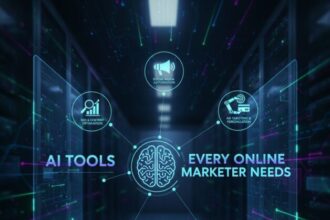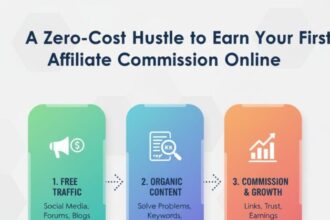So, I Tried to Learn a Skill Online. It Was a Mess. Here’s What Actually Worked.
The clock on my oven was glowing 2:17 AM. My coffee was cold, my eyes felt like they had sand in them, and my laptop screen was a blinding collage of fifty-seven different browser tabs. At least, it felt like fifty-seven.
It all started with a feeling.
You know the one I mean. That slow, creeping dread that settles in during a pointless meeting or on a Tuesday afternoon when you realize you’ve been doing the exact same thing, every single day, for years. I had a terrifyingly clear vision of myself in ten years, sitting in the same chair, with the same problems, just with a mortgage I complained about more.
I had to do something. Anything.
So, my big, brilliant plan was to learn a new skill. I figured I’d hop online, find some classes, and reinvent myself. My first search was for something like the best online learning platforms for skill development.
And that’s how the trouble started. I thought I was just looking for a website. What I found was a bizarre, hidden world with a language I didn’t understand and a million different doors, all promising to change my life. It was completely overwhelming.
This is the story of how I navigated that chaos. It’s not a guide, really. It’s more of a map of all the mistakes I made so maybe you can avoid them.
Figuring Out Where to Even Begin
So, how do you begin when you don’t even know what you’re looking for? Seriously. My first searches were a disaster. I was typing in things like “how to be better at my job,” which is apparently how you get a firehose of the most generic, useless articles on the internet blasted directly into your face.
Eventually, I noticed this acronym everywhere: MOOC. I swear, my first thought was it had something to do with cows. But no, it stands for Massive Open Online Courses. Basically, big-shot universities were putting their courses online for the masses. It sounded perfect. A world-class education without the soul-crushing debt? Yes, please.
This Stuff Has Its Own Language, Apparently
Here’s the thing they don’t tell you. The world of online courses is a jungle of jargon. I felt like I needed to take a course just to understand the courses.
Every platform had its own dialect. There was Coursera, edX, Udemy… the list went on and on. One offered a “MicroMasters.” Another had a “Professional Certificate.” Was one better than the other? I had no earthly idea. I spent an entire night just trying to figure out what a “specialization” was and why it was different from just… taking a few classes.
It was like trying to order coffee for the first time in a specialty shop. I just wanted a regular coffee, and suddenly I’m being asked about the origin of the beans and the extraction method. I just wanted to learn some basic project management!
Out of sheer frustration, I just picked one. A free marketing course from a university with a fancy name. For about a day, I felt like a genius. Look at me, learning! Then reality set in. The videos were monotone. The assignments felt like pointless busywork. The student forum was just a sad list of questions that nobody had answered. In months. I quit after a week.
My Grand Plan Face-Planted
So, my big self-improvement kick ended with me feeling even worse than when I started. I felt like a total failure. All this knowledge was right there at my fingertips, and I couldn’t even stay interested for more than a few days.
I started to think, maybe I’m just not built for this. Maybe some people can teach themselves things, and I’m just… not one of them.
I was ready to throw in the towel. But then I was complaining about it to a friend, and they sent me a link to an e-learning platforms review that wasn’t like the others. It didn’t just list features. It asked a simple question.
“How do you like to learn?” It was such an obvious question, but it had never even occurred to me. In my frantic search for the “best” platform, I never stopped to think about what was actually best for me.
The Bad Advice I Had to Ignore
That one simple question changed how I looked at everything. I started to realize that a lot of the common “wisdom” about online learning is either wrong or, at least, not one-size-fits-all. It’s based on a few ideas that sound good but just didn’t work for me in the real world. I had to unlearn a few things before I could make any real progress.
First Off, It’s Not About Willpower
This was the big one. I was convinced I failed because I was lazy. Because I didn’t have enough discipline. The internet is full of people who will tell you that you need the focus of a monk to succeed in online courses.
But I call baloney on that. It’s not about forcing yourself to do something. It’s about finding something you don’t have to force yourself to do.
That marketing course was boring. That’s why I quit. When I started looking for courses that were taught by people with a bit of energy, or that were built around a project I actually wanted to do, suddenly motivation wasn’t a problem anymore.
Nobody needs “willpower” to watch the next episode of a great TV show. You’re just pulled into it. It turns out, finding a course that actually grabs your interest is way more important than trying to guilt-trip yourself into finishing one you hate. I later found a study from the International Review of Research in Open and Distributed Learning that pretty much said the same thing—that the way a course is designed and taught makes a huge difference. So, it wasn’t just me.
The Myth of “Free”
Look, I love free stuff as much as the next person. And there are some incredible free resources out there. But I totally underestimated the psychological trick I was playing on myself.
When something is free, it has no value. It’s easy to sign up for a dozen free courses and never log into any of them. There’s no cost to quitting.
But when you pay, even a little bit, something changes. You have skin in the game. That $30 you spent is a little voice in the back of your head reminding you to actually do the thing you paid for.
I’m not saying you need to spend a lot. But the difference in my own follow-through when I paid for a course was stark. It was the difference between a library book I might get to and a book I actually bought. I just felt more committed.
And honestly, the quality is often better. The paid platforms have to compete for your business, so they tend to put more effort into making their courses engaging and supportive.
You’re Only Alone If You Choose To Be
The default image of online learning is lonely. Just you and the glow of your screen. My first experience was exactly that. It was isolating. But it doesn’t have to be.
As I kept looking, I found that the better platforms weren’t just content libraries; they were communities. They had active chat groups, live Q&A sessions, and places where students could show off their work and get feedback from real people.
Finding these communities was a game-changer.
Suddenly, I wasn’t just watching a video. I was part of a group. There were other people struggling with the same concepts, celebrating the same small victories, and generally just making the whole thing feel less like a chore and more like a shared journey. That feeling of not being the only one, I think, is a huge part of what contributes to online course effectiveness.
The Slow Realization That Changed How I Learn
Even after I got past those bad assumptions, I was still struggling to finish things. I kept signing up for these massive, in-depth professional development courses that promised to teach me an entire field from the ground up.
And I’d start strong. But eventually, life would happen. A busy week at work would knock me off schedule, and suddenly I was three weeks behind with no hope of catching up. The guilt would set in, and I’d just quietly give up.
My big breakthrough wasn’t a lightning bolt from the sky. It was more of a slow, dawning realization born of repeated failure.
I had to aim lower. A lot lower. I was trying to climb the whole mountain in one go, and it was exhausting. I was setting myself up to fail every single time.
But what if I just aimed for the first tree?
The Unbelievable Power of a Tiny Goal
This was it. This was the whole thing. I just gave up on the big goals entirely. I wasn’t going to become a “master” of anything. I was just going to learn one, tiny, ridiculously specific thing.
My entire goal for one weekend became this: I’m going to learn how to make a drop-down menu on a website. That’s it.
I found a short, project-based tutorial that focused only on that. It was specific. It was manageable. And for the first time, I actually finished something. I had a working drop-down menu to show for my efforts.
The feeling of accomplishment from that one tiny thing was more powerful than anything I’d felt before. It was a small win, but it was a win. And it made me want another one.
Shifting My Brain from “Learning” to “Making”
This changed my whole perspective. I stopped thinking about my goal as “learning.” I started thinking about it as “making.”
My objective was no longer to “complete a course.” It was to “make a thing.” A small thing. A working thing. This project-based mindset made everything feel more creative and immediate. If you’re looking for other ways to build good habits,
This is the whole secret of microlearning benefits. It takes a huge, intimidating subject and breaks it down into small, non-intimidating chunks. You can actually fit it into your life, and it gives you a steady stream of those little dopamine hits that keep you from giving up.
It’s like, instead of being paralyzed by the thought of writing a novel, you just give yourself the goal of writing one good sentence. Once you have that, the next sentence doesn’t seem so hard.
My Messy, No-Guarantees Process for Actually Doing This
So, after all that stumbling, I have a system. It’s not pretty. It’s not optimized. But it’s what I actually do, and it’s helped me learn more in the last year than I ever thought possible. Maybe you can steal some parts of it for yourself.
1. Pick a Project, Not a Platform
Seriously. This is the most important rule. Do not start by browsing course websites. It’s like going to the grocery store when you’re hungry and without a list. You will end up with a cart full of junk you don’t need and none of what you came for.
Instead, start with a tiny, specific, almost laughably small project.
Not, “Learn to use Photoshop.”
Try, “Remove the background from one photo of my dog.”
Not, “Learn to code.”
Try, “Make a webpage that has a single button on it.”
When your goal is that specific, it acts as a filter for all the noise. You’re not searching for a “course” anymore. You’re searching for a tutorial on how to do that one specific thing.
2. Learn Only Enough for the Next Step
Once you have your mini-project, resist the powerful urge to learn everything about the subject. That’s procrastination disguised as research. You’ll spend weeks learning theory and never actually make anything.
My rule is to learn only what I need for the immediate next step. I operate on a “just-in-time” basis.
For my button project, I didn’t need to know the history of programming. I literally just needed to know how to make a button appear. So that’s what I looked for. All the other stuff—making it look pretty, making it do something—could wait. This is how you build real career advancement skills—not by learning theory, but by actually doing things. It’s a method you’ll see advocated by major organizations like the World Economic Forum when they talk about the future of work.
3. Have a Go-To List of Tools
You’ll start to notice that you like certain sites for certain things. I’ve developed my own little mental toolbox for my learning projects.
For big-picture understanding, when I just need to get the lay of the land, I still find that a well-structured course on Coursera or edX can be useful.
For actually building something, I need to see it done. I love Skillshare for creative projects, and for more technical stuff, I usually find a specific, project-based class on Udemy or Pluralsight.
For when I’m just plain stuck on one stupid error, nothing beats a super-specific search on YouTube. Someone, somewhere, has had the same problem and made a video about it.
Building your own toolkit is how you create a personalized learning path that works for you, not some generic curriculum. If you’re curious about other tools that can help, check out our thoughts on the best productivity apps to complement your learning.
4. Show Your Work. Yes, Even When It’s Bad.
This is the scariest part. But it’s also the most important. You have to show someone what you made.
Even if it’s unfinished. Even if you think it’s ugly. Post a screenshot. Tell a friend. The act of sharing does two things. First, it forces you to clarify your own understanding. You can’t explain it if you don’t get it.
Second, it makes it real. It takes it out of your head and puts it into the world. It opens you up to feedback, encouragement, and connection. And that connection is what will keep you going when you feel like quitting.
So, Where Am I Now?
That guy at the kitchen table at 2 AM feels like a different person.
Am I an expert? Not even a little bit. I am still a complete hack in most of the things I’m learning.
But I’m not stuck anymore. I’ve built things. Clunky things. But things that work. I’ve designed things that are kind of ugly. But they’re my ugly things.
And it has been fun. Genuinely fun. I’ve learned that the goal isn’t to reach some destination. It’s about the process itself. It’s the little thrill you get when you finally figure something out. It’s the feeling of being a little more capable today than you were yesterday.
The world of online learning is still big and messy. But it doesn’t feel like an abyss anymore. It feels like a workshop, full of tools.
And I’m just trying to figure out what I want to build next.










































